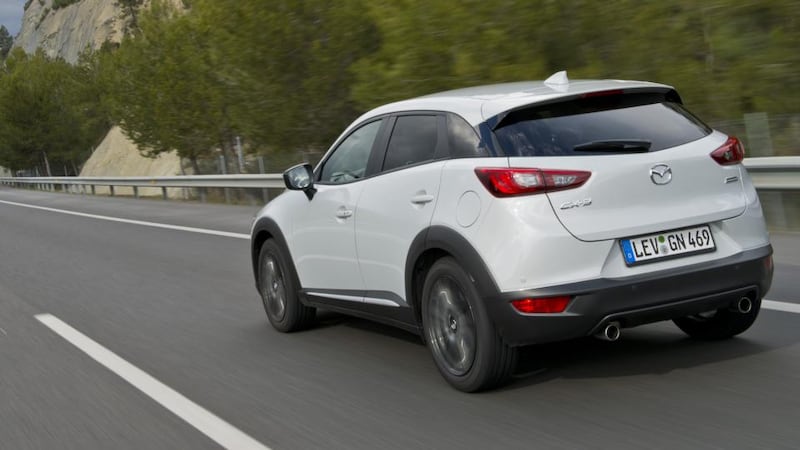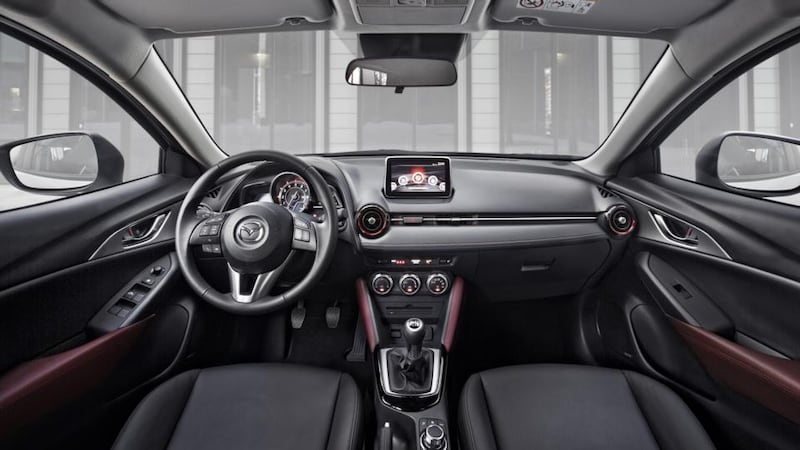Graphs. Lots and lots of graphs. So many graphs. Graphs sufficient that you could easily create a graph of the effect of graphs on my eyelids. Some car companies are content to chuck you the keys to a new model and let you off to find out all about it yourself. Not so Mazda, which decided to blind us with science. In the form of graphs. There were X and Y axis representations of everything from transient engine torque to fuel consumption to seat cushion deflection (yes, really). Mazda is proud of its new baby SUV, the CX-3, and it intended to lay out in carefully delineated numbers and coloured boxes just why it should be.
Thankfully, the CX-3's appeal stretches rather farther than mere squared-paper and protractors. Indeed, for a car that was designed on the basis of that many graphs, it's an uncommonly handsome thing. Deceptive too. At first, it's easy to think that it's merely a taller 2 or a down-sized CX-5. But see it next to a CX-5 especially, and it suddenly looks very modern, very sharp-edged, very nice. The Renault Captur is going to have some competition in the eye-catching stakes at last, while the likes of the Peugeot 2008 (too conventional) and Nissan Juke( too wacky) are rather left out in the cold.
The fact that the CX-3 shows such obvious stylistic fealty to the 2 hatchback is hardly a surprise – they are based on the same SkyActiv (Mazda-speak for light and efficient engineering) chassis and share one engine in the shape of the new 105hp 1.5-litre diesel. This engine is going to be a key unit for Mazda in Ireland – one wonders just how many 3 hatchback sales have been lost because buyers were irrationally put off by the cubic capacity of the existing 2.2-litre diesel.


It’s no mere sleeved-down version of the 2.2 either, but rather an almost entirely new engine. The turbo, the exhaust and even the pistons have been totally redesigned compared to the 2.2 and the result, claims Mazda, is one of the lightest, most frugal and efficient diesel engines in its class. Now, we’ve been stung by Mazda’s fuel efficiency claims before – the 2.2 diesel in CX-5, 6 and 3 rarely, if ever, approaches its claimed economy figures in the real world but on the basis of this brief test drive, the 1.5 gets rather closer. Mazda claims 4.0-litres per 100km (or a full-on 70mpg). We didn’t get near that, not even close, but we were driving almost exclusively in stop-start town traffic, and in an model equipped with optional four wheel drive, so our recored 43mpg is perhaps not bad, for real-world conditions. The only disappointment really is that the 105g/km Co2 figure fails to ‘do a Qashqai’ and dip below the psychologically important 100g/km barrier.
While Ireland remains a three-quarter-heavy diesel market, it would be unwise to ignore the CX-3’s petrol option. The 2.0-litre SkyActiv engine is deeply unfashionable, doing as it does without a turbo or a small capacity, but Mazda reckons it knows better than the rest of the motoring world, and that having a torque-y, under-stressed larger engine is the way to both economy and happiness. And it might just be right – the 2.0-litre unit is free-revving, refined, smooth, lovely to drive and, over a mixed route of mountain roads, motorway and city driving, returned the same 43mpg we squeezed out of the (significantly noisier) diesel, and it will only cost you €280 a year to tax. We know that the CX-3 range will kick off at €20,695 but we do’t quite know yet what premium will be asked for the diesel model. If it’s a hefty one, and your regular journeys are all about brevity, then petrol could well be the best way to go with the CX-3.
This being Mazda, a reference to the iconic MX-5 was never far from the surface, and with classic models such as a Mk1 MX-5, a Mk1 RX-7 and even a sixties Cosmo rotary coupe on display at the launch location, Mazda was keen to remind us that this compact SUV comes from a car company obsessed with sports cars. So it’s good to drive, then – hardly a surprise. It would be even better if the steering had some proper, real road-feel but it’s nicely weighted and the car feels really stable and ‘planted’ on pretty much any road. Agility is good on twisting mountain passes and it still feels small enough to be city-friendly. The ride quality is good too – firmly sprung and damped, and occasionally a bit bouncy over speed bumps, but otherwise calm and smooth. The only question mark remains over refinement. On smooth roads, the CX-3 was comfortably silent inside, but rougher surfaces threw up signifiant tyre noise. All our test cars were pre-production models so it will take a good run at home, on familiar roads, to get a proper fix on that.
At least the cabin itself is nice. The seats are comfy (much talk about finding a sweet-spot between being high for visibility and low for sportiness) and supportive and the cabin quality very, very high indeed. The instrument pack still looks to my eyes a little under-done (it’s basically the same as what you get on the 2 and 3) and the tiny rev-counter and button-strewn steering wheel are oddities, but it’s an environment in which you soon feel comfy. Mazda is really pushing the safety aspects of the CX-3 – it can be had with an autonomous braking system, active cruise, crossing-traffic alert (for when you’re reversing out of a parking space) and LED headlights with an active high-beam. How expensive all of that will be is another matter, but it’s nice to know it’s all there. Mind you, there are some limitations. The self-braking system is designed to detect cars ahead of you, not pedestrians or cyclists and while the system works up to 30kmh, the active cruise control cuts off at that speed and there’s a gap between the two at which point you’re on your own, son. Mazda says that it’s working on expanding the parameters of both systems.
On the practical front, space in the back feels a touch tight (certainly not as good as the roomy 2008, but better by far than the Juke) and the boot, at 350-litres, is decent but not exceptional. The CX-3, like so many other SUVs, pays only lip service to the U component.
One thing the graphs did achieve was to show just how much careful thought has gone into the CX-3. It looks and feels like a really finely-honed vehicle, albeit one that could do with a touch more interior space to be truly practical. But it’s certainly the best car in its class to drive, arguably the best-looking and given Mazda’s reliability reputation, likely to be one of the most robust too. If the basic €20,695 model comes with decent equipment as standard (it’s still being thrashed out as I write) then this could be the pick of the small SUV bunch, but make sure you try the petrol before deciding on the diesel.
The lowdown:
Mazda CX-3 1.5 SkyActiv D
Price: TBA but starting at €20,695
Power: 105hp.
Torque: 270Nm.
0-100kmh: 10.1sec.
Top speed: 177kmh.
Claimed economy: 4.0l/100km. (70mpg)
Co2 emissions: 105g/km.
Motor tax: €190.
Verdict: Really well thought out and executed, and darned handsome too. Good to drive but space in the back is a little tight.
4/5.












